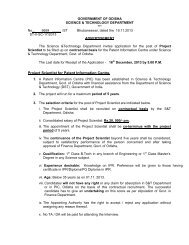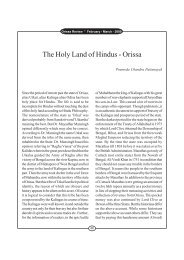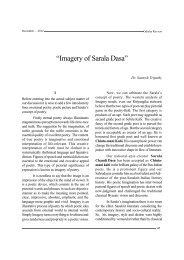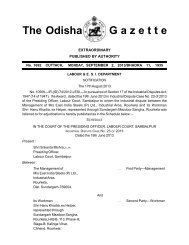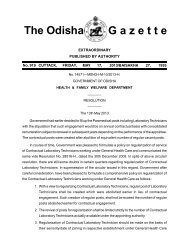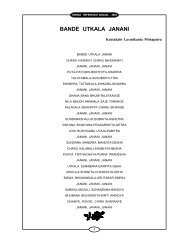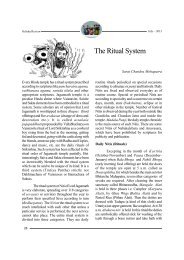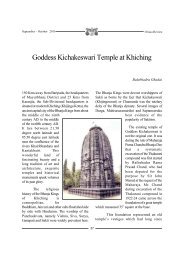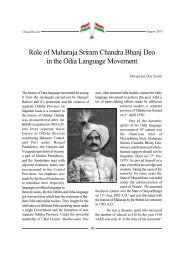Laxmi-Narayan Discord in Jagannath Religion
Laxmi-Narayan Discord in Jagannath Religion
Laxmi-Narayan Discord in Jagannath Religion
You also want an ePaper? Increase the reach of your titles
YUMPU automatically turns print PDFs into web optimized ePapers that Google loves.
out of the famous car festival of the Lords.<br />
This is observed <strong>in</strong> the temple on the twelfth<br />
day of the car festival. The discord is related<br />
to a dialogue between Mahalaxmi and<br />
<strong>Jagannath</strong>a. Countless devotees enjoy the ritual<br />
at the time of Lord's entry <strong>in</strong>to the temple after<br />
the Bahuda Yatra. As the ritual ensues,<br />
Mahalaxmi does not open the doors of the<br />
temple at the Jay -Vijaya entrance. <strong>Jagannath</strong>a,<br />
as a result, is stranded outside. Balabhadra is<br />
however taken <strong>in</strong>side the temple. He is as usual<br />
seated on the Ratnavedi, the div<strong>in</strong>e platform<br />
of Jewel. It is said, Mahalaxmi stoops to this<br />
action out of awful anguish. Her anger is<br />
caused due to the fact that she was not allowed<br />
to accompany <strong>Jagannath</strong>a dur<strong>in</strong>g the Gundicha<br />
Yatra, although the Lord took his sister,<br />
Subhadra <strong>in</strong> pomp and ceremony. Stranded<br />
outside, <strong>Jagannath</strong>a entreats Mahalaxmi to<br />
open the door of the entrance. He gives out<br />
several explanations <strong>in</strong> the forms of <strong>in</strong>sistent<br />
appeals. The flared outburst of Mahalaxmi and<br />
the humble appeals of <strong>Jagannath</strong>a Mahapravu<br />
thus constitute the <strong>Laxmi</strong> <strong>Narayan</strong> dialogue.<br />
This is an important ritual of the Temple. The<br />
dialogue is conta<strong>in</strong>ed <strong>in</strong> verse form. The ritual<br />
perta<strong>in</strong><strong>in</strong>g to the dialogue is celebrated <strong>in</strong> the<br />
temple for about an hour. Thereafter, with<br />
Mahalaxmi's permission, the doors of the<br />
temple are made ajar and the Lord is taken<br />
<strong>in</strong>side <strong>in</strong> a grand procession to adorn his seat<br />
on the div<strong>in</strong>e platform. This is the mystic<br />
background of the famous <strong>Laxmi</strong>-<strong>Narayan</strong><br />
dialogue.<br />
The purpose of this endeavor is to make<br />
a realistic study on this dialogue. An attempt<br />
is made here to present the gist of the dialogue<br />
<strong>in</strong> a prosaic order. Mahalaxmi flares her violent<br />
outbursts like an angry wife neglected by her<br />
husband. However harsh and rasp<strong>in</strong>g her<br />
outbursts may appear, they are symbolic of an<br />
Orissa Review * June - 2006<br />
63<br />
endear<strong>in</strong>g appeal to Lord <strong>Jagannath</strong>a. This is<br />
most common <strong>in</strong> the case of a wife <strong>in</strong> her lov<strong>in</strong>g<br />
and dutiful behaviour towards her husband. The<br />
display of her passionate conduct is all a fuss.<br />
In the end, it ultimately turns out as much ado<br />
about noth<strong>in</strong>g. The disharmony at last<br />
dissipates like the transient morn<strong>in</strong>g dews <strong>in</strong><br />
the usual passage of time. Mahalaxmi adapts<br />
herself to the ongo<strong>in</strong>g situation and f<strong>in</strong>ally w<strong>in</strong>s<br />
over her husband. This is wife and husband<br />
relationship <strong>in</strong> the usual go of life. This spirit<br />
is depicted <strong>in</strong> a picturesque way <strong>in</strong> the famous<br />
<strong>Laxmi</strong>-<strong>Narayan</strong> dialogue, full of realities <strong>in</strong><br />
filial behavior. The general theme of the<br />
dialogue, as followed <strong>in</strong> different parts of India,<br />
is almost the same. But the style and rhythm<br />
of the dialogue are different <strong>in</strong> different parts<br />
where the car festival is celebrated. The<br />
dialogue was once prevalent only <strong>in</strong> Oriya. But<br />
as th<strong>in</strong>gs now prevail, the dialogue is written<br />
<strong>in</strong> different languages. In some places, the ritual<br />
of <strong>Laxmi</strong>-<strong>Narayan</strong> dialogue is not at all<br />
observed. The images, after the Bahuda Yatra,<br />
are straightway taken to the sanctum sanctrum<br />
of the temple. The <strong>Laxmi</strong>-<strong>Narayan</strong> dialogue<br />
where it is <strong>in</strong> vogue, has been, by and large,<br />
formulated conform<strong>in</strong>g to the themes and<br />
contents of 'Deulatola' of Sisu Krushna Das,<br />
'Bramha Puran' and 'Skanda Puran', the sacred<br />
treatises on <strong>Jagannath</strong>a religion. In some<br />
places, the dialogue as published by Hari Arjun<br />
Company is also ceremoniously followed for<br />
observance of the ritual. The dialogue is always<br />
recited <strong>in</strong> verse form. But, the Ragas followed<br />
are different <strong>in</strong> different parts of Orissa.<br />
In the expressions of some devout poets<br />
of <strong>Jagannath</strong>a religion, the Lord's attitud<strong>in</strong>al<br />
disposition is not to the lik<strong>in</strong>g of the common<br />
people of the society. How can he neglect<br />
Mahalaxmi, his chief consort while mov<strong>in</strong>g out<br />
on the div<strong>in</strong>e sojourn ? The poets say,



